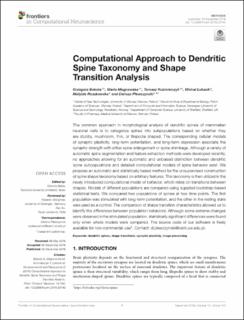| dc.contributor.author | Bokota, Grzegorz | |
| dc.contributor.author | Magnowska, Marta | |
| dc.contributor.author | Kusmierczyk, Tomasz | |
| dc.contributor.author | Lukasik, Michal | |
| dc.contributor.author | Roszkowska, Matylda | |
| dc.contributor.author | Piewczynski, Dariusz | |
| dc.date.accessioned | 2020-03-25T10:33:37Z | |
| dc.date.available | 2020-03-25T10:33:37Z | |
| dc.date.created | 2017-01-30T09:41:49Z | |
| dc.date.issued | 2016 | |
| dc.identifier.citation | Frontiers in Computational Neuroscience. 2016, 10 | en_US |
| dc.identifier.issn | 1662-5188 | |
| dc.identifier.uri | https://hdl.handle.net/11250/2648533 | |
| dc.description.abstract | The common approach in morphological analysis of dendritic spines of mammalian neuronal cells is to categorize spines into subpopulations based on whether they are stubby, mushroom, thin, or filopodia shaped. The corresponding cellular models of synaptic plasticity, long-term potentiation, and long-term depression associate the synaptic strength with either spine enlargement or spine shrinkage. Although a variety of automatic spine segmentation and feature extraction methods were developed recently, no approaches allowing for an automatic and unbiased distinction between dendritic spine subpopulations and detailed computational models of spine behavior exist. We propose an automatic and statistically based method for the unsupervised construction of spine shape taxonomy based on arbitrary features. The taxonomy is then utilized in the newly introduced computational model of behavior, which relies on transitions between shapes. Models of different populations are compared using supplied bootstrap-based statistical tests. We compared two populations of spines at two time points. The first population was stimulated with long-term potentiation, and the other in the resting state was used as a control. The comparison of shape transition characteristics allowed us to identify the differences between population behaviors. Although some extreme changes were observed in the stimulated population, statistically significant differences were found only when whole models were compared. The source code of our software is freely available for non-commercial use1. Contact: d.plewczynski@cent.uw.edu.pl. | en_US |
| dc.language.iso | eng | en_US |
| dc.publisher | Frontiers Media | en_US |
| dc.rights | Navngivelse 4.0 Internasjonal | * |
| dc.rights.uri | http://creativecommons.org/licenses/by/4.0/deed.no | * |
| dc.title | Computational approach to dendritic spine taxonomy and shape transition analysis | en_US |
| dc.type | Peer reviewed | en_US |
| dc.type | Journal article | en_US |
| dc.description.version | publishedVersion | en_US |
| dc.source.volume | 10 | en_US |
| dc.source.journal | Frontiers in Computational Neuroscience | en_US |
| dc.identifier.doi | 10.3389/fncom.2016.00140 | |
| dc.identifier.cristin | 1440659 | |
| dc.description.localcode | Copyright © 2016 Bokota, Magnowska, Kuśmierczyk, Łukasik, Roszkowska and Plewczynski. This is an open-access article distributed under the terms of the Creative Commons Attribution License (CC BY). The use, distribution or reproduction in other forums is permitted, provided the original author(s) or licensor are credited and that the original publication in this journal is cited, in accordance with accepted academic practice. No use, distribution or reproduction is permitted which does not comply with these terms. | en_US |
| cristin.ispublished | true | |
| cristin.fulltext | original | |
| cristin.qualitycode | 1 | |

